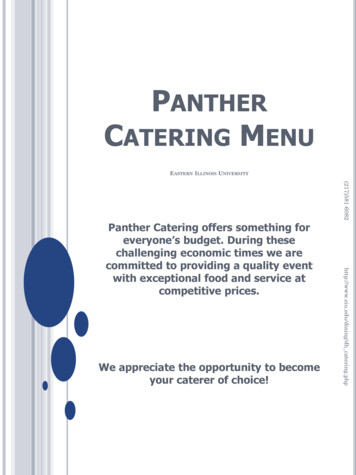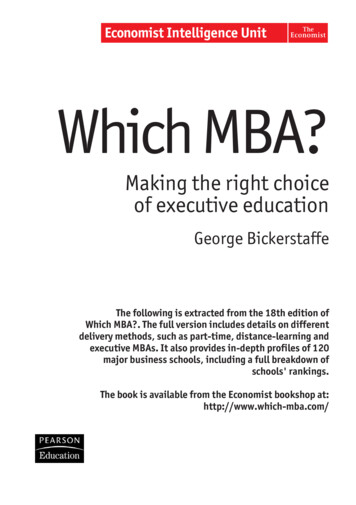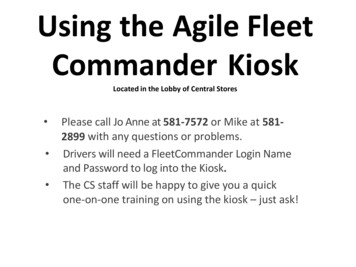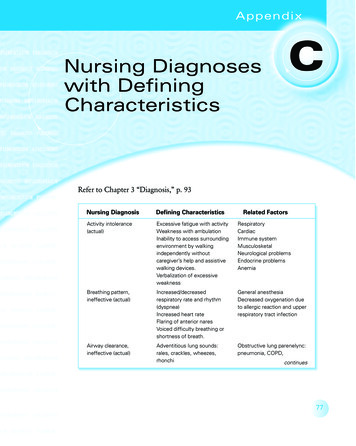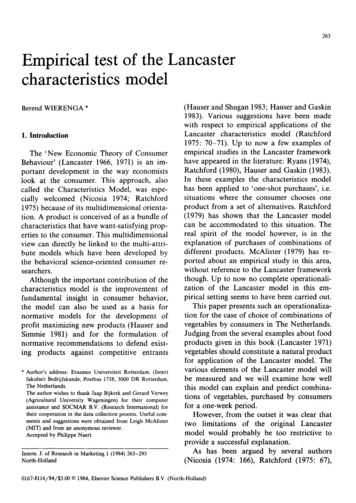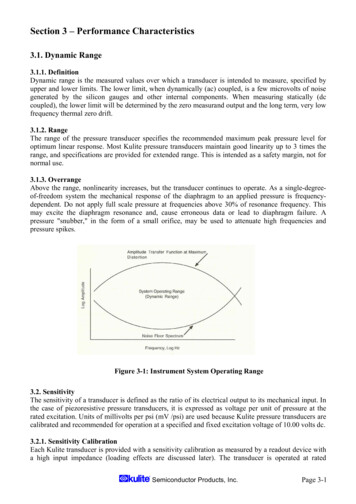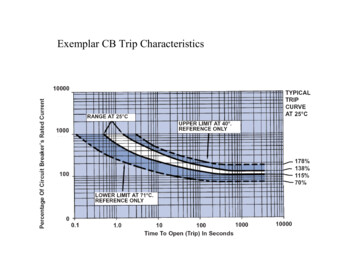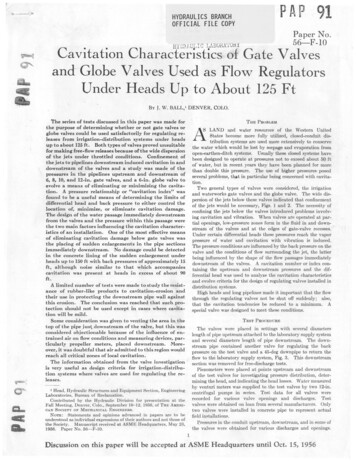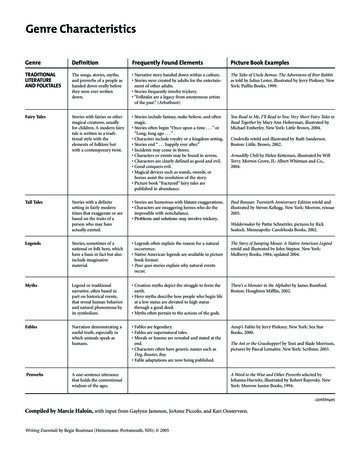
Transcription
Genre CharacteristicsGenreDefinitionFrequently Found ElementsPicture Book ExamplesTRADITIONALLITERATUREAND FOLKTALESThe songs, stories, myths,and proverbs of a people ashanded down orally beforethey were ever writtendown. Narrative story handed down within a culture. Stories were created by adults for the entertainment of other adults. Stories frequently involve trickery. “Folktales are a legacy from anonymous artistsof the past.” (Arbuthnot)The Tales of Uncle Remus: The Adventures of Brer Rabbitas told by Julius Lester, illustrated by Jerry Pinkney. NewYork: Puffin Books, 1999.Fairy TalesStories with fairies or othermagical creatures, usuallyfor children. A modern fairytale is written in a traditional style with theelements of folklore butwith a contemporary twist. Stories include fantasy, make believe, and oftenmagic. Stories often begin “Once upon a time . . . ” or“Long, long ago . . . ” . Characters include royalty or a kingdom setting. Stories end “ . . . happily ever after.” Incidents may come in threes. Characters or events may be found in sevens. Characters are clearly defined as good and evil. Good conquers evil. Magical devices such as wands, swords, orhorses assist the resolution of the story. Picture book “fractured” fairy tales arepublished in abundance.You Read to Me, I’ll Read to You: Very Short Fairy Tales toRead Together by Mary Ann Hoberman, illustrated byMichael Emberley. New York: Little Brown, 2004.Stories with a definitesetting in fairly moderntimes that exaggerate or arebased on the traits of aperson who may haveactually existed. Stories are humorous with blatant exaggerations. Characters are swaggering heroes who do theimpossible with nonchalance. Problems and solutions may involve trickery.Paul Bunyan: Twentieth Anniversary Edition retold andillustrated by Steven Kellogg. New York: Morrow, reissue2005.LegendsStories, sometimes of anational or folk hero, whichhave a basis in fact but alsoinclude imaginativematerial. Legends often explain the reason for a naturaloccurrence. Native American legends are available in picturebook format. Pour quoi stories explain why natural eventsoccur.The Story of Jumping Mouse: A Native American Legendretold and illustrated by John Steptoe. New York:Mulberry Books, 1984, updated 2004.MythsLegend or traditionalnarrative, often based inpart on historical events,that reveal human behaviorand natural phenomena byits symbolism. Creation myths depict the struggle to form theearth. Hero myths describe how people who begin lifeat a low status are elevated to high statusthrough a good deed. Myths often pertain to the actions of the gods.There’s a Monster in the Alphabet by James Rumford.Boston: Houghton Mifflin, 2002.FablesNarration demonstrating auseful truth, especially inwhich animals speak ashumans. Fables are legendary. Fables are supernatural tales. Morals or lessons are revealed and stated at theend. Characters often have generic names such asDog, Rooster, Boy. Fable adaptations are now being published.Aesop’s Fables by Jerry Pinkney. New York: Sea StarBooks, 2000.Tall TalesProverbsCinderella retold and illustrated by Ruth Sanderson.Boston: Little, Brown, 2002.Armadilly Chili by Helen Ketteman, illustrated by WillTerry. Morton Grove, IL: Albert Whitman and Co.,2004.Widdermaker by Pattie Schnetzler, pictures by RickSealock. Minneapolis: Carolrhoda Books, 2002.A one-sentence utterancethat holds the conventionalwisdom of the ages.The Ant or the Grasshopper? by Toni and Slade Morrison,pictures by Pascal Lemaitre. New York: Scribner, 2003.A Word to the Wise and Other Proverbs selected byJohanna Hurwitz, illustrated by Robert Rayevsky. NewYork: Morrow Junior Books, 1994.continuesCompiled by Marcie Haloin, with input from Gaylynn Jameson, JoAnne Piccolo, and Kari Oosterveen.Writing Essentials by Regie Routman (Heinemann: Portsmouth, NH); 2005
GENRE CHARACTERISTICS2GenreDefinitionFrequently Found ElementsPicture Book ExamplesPERSONALNARRATIVESA record of events based onthe writer’s own observation. Memoirs may cover only one event or aspect ofthe author’s life. Memoir is a retrospective account of a memorable event. Memoirs for children can be fictionalized.Waiting to Waltz, a Childhood: Poems by Cynthia Rylant,drawings by Stephen Gammell. New York: Atheneum,2001. Entries are usually dated. Diaries and journals in series have beenpublished as a way of sharing historical fiction. Fictional diaries can be animal fantasies whenanimals write them.Only Opal: The Diary of a Young Girl by Opal Whiteley,selected [and adapted] by Jane Boulton, illustrations byBarbara Cooney. New York: Paperstar, 1997. Letters provide authentic ways for communication. Letters, postcards, and emails are all personalwritten communications with different conventions and elements. Postcards are abbreviated forms of letters andhave abbreviated elements. Emails have become even more abbreviatedforms of communication and have developedan extensive short-cut and very informal style.The Jolly Postman, or Other People’s Letters by Janet andAllan Ahlberg. Boston: Little, Brown, 1986.MemoirsJournals andDiariesLetters, Postcards,PersonalCorrespondenceA log written by an authorat regular intervals.Personal written communications.Don’t You Know There’s a War On? by James Stevenson.New York: Greenwillow Books, 1992.Diary of a Worm by Doreen Cronin, pictures by HarryBliss. New York: Joanna Cotler Books, 2003.Toot and Puddle by Hollie Hobbie. New York: Scholastic,printing 2001.AutobiographiesA story of a person’s lifewritten by that person. First-person account. Often highly personalized. May be supported by authentic pictures andnewspaper articles.Through My Eyes: [the Autobiography of] Ruby Bridges.New York: Scholastic Press, 1999.IndividualBiographiesA story of a person’s lifewritten by an individualwith exceptional knowledgeof the subject. Accurate history of a person’s life. Reflection of the time and place in which aperson lived. Usually chronological. Carefully researched and authentic. Fictionalized biographies may include invention, supposition, or inference. Many historicalfiction books are biographical fiction. Subject may be an historical or contemporaryfigure.When Marian Sang: The True Recital of MarianAnderson, the Voice of a Century, libretto by Pam MuñozRyan, staging by Brian Selznick. New York: ScholasticPress, 2002.CollectiveBiographiesBiographies of many individuals in the same book. Usually grouped for author’s purpose. May include a standard format for each person.Lives of Extraordinary Women – Rulers, Rebels (and Whatthe Neighbors Thought) by Kathleen Krull, illustrated byKathryn Hewitt. Scholastic, 2001 (series).INFORMATIONALBOOKSFactual presentations ofdocumented knowledge. Nonfiction text dealing with an actual, real-lifesubject. Major types include chapter books, picturebooks, photographic essays, and informationalbooks with a narrative blend. Elements of expository writing are description,time sequence, enumeration, cause and effect,and comparison/contrast. Nonfiction picture books can serve as modelsfor student content reports.Ice-cream Cones for Sale! by Elaine Greenstein. NewYork: Arthur A. Levine Books, 2003.What Do You Do with a Tail Like This? by Steve Jenkinsand Robin Page. Boston: Houghton Mifflin, 2003.Pig by Jules Older, illustrated by Lyn Severance.Watertown, MA: Charlesbridge, 2004.continuesWriting Essentials by Regie Routman (Heinemann: Portsmouth, NH); 2005
GENRE CHARACTERISTICS3GenreDefinitionFrequently Found ElementsPicture Book ExamplesEssaysA short literary composition that reflects theauthor’s outlook or point ofview. Often of a persuasive nature. May be found in collections. Frequently found in magazines and periodicals.Vote! by Eileen Christelow. New York: Clarion Books,2003.ProcessExplanationsAn essay that explains howto do something. Written in sequential order. Steps usually are enumerated. Explains the procedures for accomplishing a task.Follow the Money! written and illustrated by LoreenLeedy. New York: Holiday House, 2002.FICTIONStories from an author’simagination usually with anemphasis on characterdevelopment. May berealistic or not (see variouscategories following). Usually located in libraries in separate areas forpicture books and “chapter books” and novels. Libraries may place genre stickers on the spinesto make selection easier. Some can be classified into multiple genres(e.g., combination of fiction, information,poetry, narratives, etc.). Multi-genre books and multi-genre research isencouraged as a way to allow students to writeand use a variety of learning styles.Home at Last by Susan Middleton Elya, illustrated byFelipe Davalos. New York: Lee and Low Books, 2002.Books with many pictureswhere the story dependsupon the pictures. Therecan be picture books ofalmost any genre. Alphabet and counting books are presented inalphabetical or numeric order often linked by anidentifying theme. These make excellent participation stories and patterns for writing. They maybe located in the nonfiction area of a library. Concept books attempt to define an abstract idea. Mother Goose, nursery rhymes, and bookswritten in rhyme present traditional rhymes aswell as modern short rhymes. Most are locatedin the nonfiction area of a library. Wordless picture books contain few or no wordsas the pictures tell the story. Many teachers havestudents write narratives for these models. Predictable books are designed to help childrenlearn to read by use of repetition of language,story patterns, or sequences. They often areexcellent models for writing patterns. Cumulative Stories are imaginative narrativesthat have a series of additions. After each addition the previous phrases are then repeated inreverse order.The Skull Alphabet Book by Jerry Pallotta, illustrated byRalph Masiello. Watertown, MA: Charlesbridge; 2002. May be based upon dates, people, or events thatreally happened. Major historical event may be an essential. Accuracy of the historical detail is evident. May include author notes on research. Categories of historical fiction are based uponthe time period or historical era. Characters and time periods are lifelike. Conflict allows children to compare the pastwith the present in order to better understandour world.White Socks Only by Evelyn Coleman, illustrated byTyrone Geter. Morton Grove, IL: A. Whitman, 1996.Picture BooksHistorical FictionImaginative stories withfictional characters andevents in a historical setting.Linda Brown, You Are Not Alone: The Brown v. Board ofEducation Decision, a collection edited by Joyce CarolThomas, illustrated by Curtis James. New York:Hyperion, 2003.Visiting Day by Jacqueline Woodson, illustrated byJames Ransome. New York: Scholastic Press, 2002.Dogs, Dogs, Dogs by Leslea Newmann, illustrated byErika Oller. New York: Simon and Schuster, 2002.Here Comes Mother Goose edited by Iona Opie, illustrated by Rosemary Wells. Cambridge, MA: CandlewickPress, 1999.Home by Jeannie Baker. New York: Greenwillow Books,2004.Bark, George by Jules Feiffer. New York: HarperCollinsPublishers, 1999.My Little Sister Ate One Hare by Bill Grossman, illustrated by Kevin Hawkes. New York: Scholastic, 1997.The Cello of Mr. O by Jane Cutler, illustrated by GregCouch. New York: Dutton Children’s Books, 1999.continuesWriting Essentials by Regie Routman (Heinemann: Portsmouth, NH); 2005
GENRE CHARACTERISTICS4GenreDefinitionFrequently Found ElementsPicture Book ExamplesAdventure StoriesStories of survival or life inthe great outdoors. Characters succeed without adult assistance. Characters, often children, encounter situationsthat require quick thinking, problem solving,and inner strength.Beardream by Will Hobbs, illustrated by Jill Kastner.New York: Atheneum Books for Young Readers, 1997.Sports StoriesEvents and activities withinthe story deal with thecharacters’ participation insports. Characters struggle with issues related to sports. Team sports are usually emphasized. Plot and characterization often emphasizetheses such as team play and sportsmanship.The Captain Contest by Matt Christopher, illustrated byDaniel Vasconcellos. Boston: Little, Brown, 1999.Animal RealismAn imaginative story inwhich an animal is a centralcharacter that behaves in amanner true to the breed;usually realistic. Realistic animal stories may be difficult to writebecause the author must have extensive knowledge of the species. The central character behaves in a manner trueto the breed. Problems are realistic for an animal.Dogteam by Gary Paulsen, illustrated by Ruth WrightPaulsen. New York: Delacorte Press, [1993].FANTASYFiction with strange orotherworldly settings orcharacters; fiction thatinvites suspension of reality;fiction that depends onmagic or the impossible orinexplicable.Divided into low fantasy (world governed by thelaws of this world but inexplicable things occur)and high fantasy (set in a secondary world ofmagic and inhabited by supernatural beings orcreatures).The Great Redwall Feast by Brian Jacques, illustrated byChristopher Denise. New York: Philomel Books, 1996(series).Animal FantasyForm of fantasy in whichthe main characters areanimals. Animal stories arecharacterized by the extentto which the animals takeon human characteristics. In one type the animal behaves like its species,but thinks and talks like a human. In another type the animal acts both like itsspecies but also like a human. In a third type the animal behaves, speaks, anddresses totally like a human. This is verycommon in family stories, stories of everydayexperiences, and friendship stories.Bertie Was a Watchdog by Rick Walton, illustrated byArthur Robins. Cambridge, MA: Candlewick Press,2002.A Day in the Life of Murphy by Alice Provensen. NewYork: Simon & Schuster Books for Young Readers, 2003.Dear Mrs. Larue: Letters from Obedience School writtenand illustrated by Mark Teague. New York: ScholasticPress, 2002.The Pigeon Finds a Hot Dog! by Mo Willems. New York:Hyperion Books for Children, 2004.Science FictionREALISTICFICTIONSet in a future that scientificor technological advancecould or might makepossible. In one approach the story usually takes place inouter space where the technology of the futureis predicted. In the other approach future societies areportrayed, usually on earth, with or without thepresence of aliens. Themes frequently deal with good or evil, ofteninvolving technology. Science Fantasy uses science “to explain theexistence of the world and magic is used thereafter.”Zathura: A Space Adventure by Chris Van Allsburg.Boston: Houghton Mifflin, 2002.A story that can actuallyhappen and is true to life. Realistic characters with possible problems. Outcomes are reasonable and plausible. Settings can be contemporary or historical. Family stories, school stories, animal stories,mysteries, could all be included in this genre.John Philip Duck by Patricia Polacco. New York:Philomel, 2004.Commander Toad and the Voyage Home by Jane Yolen,pictures by Bruce Degen. New York: Putnam’s, 1998(series).Gettin’ through Thursday by Melrose Cooper, illustratedby Nneka Bennett. New York: Lee & Low Books, 1998.continuesWriting Essentials by Regie Routman (Heinemann: Portsmouth, NH); 2005
GENRE CHARACTERISTICS5GenreDefinitionFrequently Found ElementsPicture Book ExamplesContemporaryRealistic FictionAccurately depicts life as itcould be lived today. Themes are contemporary and may tend to becontroversial. Current political and social issues and kids’problems may be explored. “Contemporary” means that by its nature thegenre is always changing.Raymond’s Perfect Present by Therese On Louie; illustrated by Suling Wang. New York: Lee & Low Books,2002.The Recess Queen by Alexis O’Neill, illustrated by LauraHuliska-Beith. New York: Scholastic, 2002.MysteriesImaginative stories dealingwith the solution of asecret, problem, or crime,and involving suspense orintrigue. Suspense. Cliffhangers. Foreshadowing. Detective stories and spy novels. Often are available in series.The Mystery of the Monkey’s Maze, story and pictures byDoug Cushman. New York: HarperCollins Publishers,1999.POETRYAlthough difficult to define,poetry is brief, intense, andpatterned when comparedwith prose. “Poetry is a typeof literature in which thesound and meaning oflanguage are compiled tocreate ideas and feelings.”(Arbuthnot) Creates an emotional intensity. Varieties include rhyme, ballads, lyrics, narrativepoems, free verse, haiku, limericks, concretepoems, cinquain, and diamante. Uses rhythmic or figurative language: alliteration, metaphor, simile, symbolism, personification, assonance, consonance, allusion,onomatopoeia, internal rhyme, and rhymescheme. Uses imagery, compactness, shape. Anthologies.The Random House Book of Poetry for Children selectedand introduced by Jack Prelutsky, illustrated by ArnoldLobel. New York: Random House, 1983. (Excellentsubject index.)Public address or discourse. Script written to be read orally or performed. Reader’s Theatre can be performed with scriptswritten specifically for that purpose. Teachers have written many stories into Reader’sTheatre scripts.Fifty Fabulous Fables: Beginning Readers Theatre bySuzanne I. Barchers. Englewood, CO: Teacher IdeasPress, 1997.SPEECH, DRAMA,AND READER’STHEATRELeap Into Poetry: More ABCs of Poetry by Arvis Harley.Honesdale, PA: Boyds Mills Press, 2001.Kids’ Poems: Teaching First Graders to Love Writing Poetryby Regie Routman. New York: Scholastic, 2000 (series).Readers Theatre for American History by Anthony D.Fredericks. Englewood, CO: Teacher Ideas Press, 2001.Arbuthnot, May Hill. The Arbuthnot Anthology of Children’s Literature, New York: Scott Foresman and Company, 1961. Hancock, Marjorie R. A Celebration of Literature and Response:Children, Books, and Teachers in K-8 Classrooms, Second Edition, New Jersey: Pearson Merrill Prentice Hall, 2004. Hillman, Judith. Discovering Children’s Literature 3rd Edition. NewJersey. Pearson Merrill Prentice Hall, 2003. Larsen, Karen, Handy Dandy List of Genres, Compiled by Karen Larsen. Adams Twelve School District, Westminster, CO: August 2003.Lukens, Rebecca J. A Critical Handbook of Children’s Literature. Boston: Allyn and Bacon, 2003. Nixon, Norma The New Children’s Literature Guide K-6. Cherry Creek School District.Aurora, Colorado, 1991.Writing Essentials by Regie Routman (Heinemann: Portsmouth, NH); 2005
Multi-genre books and multi-genre research is encouraged as a way to allow students to write and use a variety of learning styles. Picture Books Books with many pictures where the story depends upon the pictures. There can be picture books of almost any genre. The Skull Alpha


